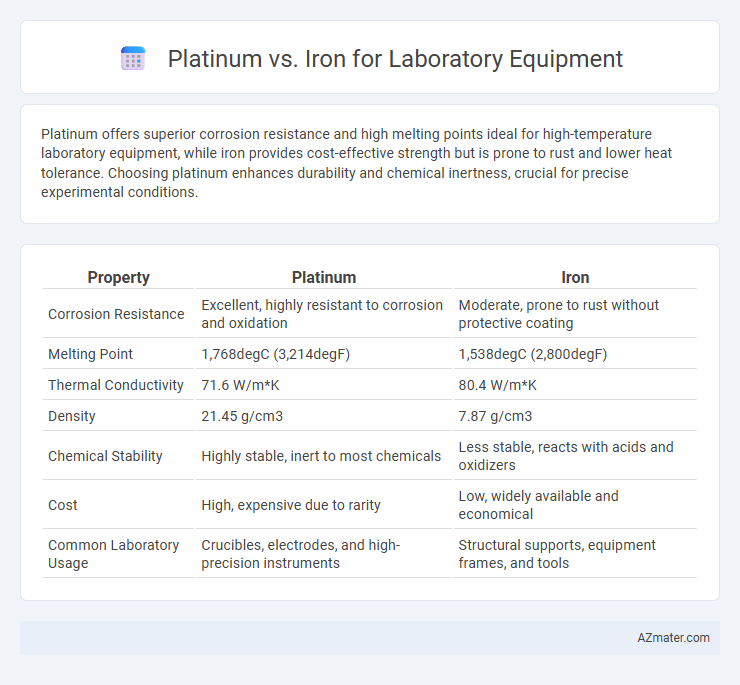Platinum offers superior corrosion resistance and high melting points ideal for high-temperature laboratory equipment, while iron provides cost-effective strength but is prone to rust and lower heat tolerance. Choosing platinum enhances durability and chemical inertness, crucial for precise experimental conditions.
Table of Comparison
| Property | Platinum | Iron |
|---|---|---|
| Corrosion Resistance | Excellent, highly resistant to corrosion and oxidation | Moderate, prone to rust without protective coating |
| Melting Point | 1,768degC (3,214degF) | 1,538degC (2,800degF) |
| Thermal Conductivity | 71.6 W/m*K | 80.4 W/m*K |
| Density | 21.45 g/cm3 | 7.87 g/cm3 |
| Chemical Stability | Highly stable, inert to most chemicals | Less stable, reacts with acids and oxidizers |
| Cost | High, expensive due to rarity | Low, widely available and economical |
| Common Laboratory Usage | Crucibles, electrodes, and high-precision instruments | Structural supports, equipment frames, and tools |
Introduction: Platinum vs Iron in Laboratory Equipment
Platinum exhibits exceptional resistance to corrosion and high temperatures, making it ideal for laboratory equipment requiring durability and chemical inertness. Iron, while more affordable and widely available, tends to oxidize and corrode when exposed to harsh chemicals and extreme heat in lab conditions. The choice between platinum and iron in laboratory equipment hinges on balancing platinum's superior longevity and performance against iron's cost-effectiveness and mechanical strength.
Material Properties and Chemical Stability
Platinum exhibits superior chemical stability and corrosion resistance compared to iron, making it ideal for high-temperature and acidic environments in laboratory equipment. Iron, while more cost-effective, is prone to oxidation and rust, limiting its use in corrosive conditions. The high melting point and inert nature of platinum ensure long-term durability and minimal contamination during sensitive chemical experiments.
Resistance to Corrosion and Oxidation
Platinum exhibits superior resistance to corrosion and oxidation compared to iron, making it ideal for laboratory equipment exposed to harsh chemicals and high temperatures. Iron tends to oxidize and rust quickly when exposed to moisture and reactive substances, compromising its durability and performance. Platinum's inert properties ensure long-lasting stability and reliability in demanding laboratory environments.
Thermal Conductivity and Heat Tolerance
Platinum exhibits superior heat tolerance compared to iron, withstanding temperatures up to 1,768degC before melting, making it ideal for high-temperature laboratory applications. Its thermal conductivity, around 71.6 W/m*K, allows for efficient heat distribution, though it is lower than iron's thermal conductivity of approximately 80.2 W/m*K. The combination of platinum's exceptional heat tolerance and adequate thermal conductivity ensures reliable performance in precise laboratory procedures requiring sustained high temperatures.
Reactivity with Laboratory Chemicals
Platinum exhibits exceptional resistance to corrosion and oxidation when exposed to strong acids, bases, and organic solvents, making it ideal for handling highly reactive laboratory chemicals. Iron, while durable and cost-effective, is susceptible to rust and corrosion, especially in the presence of acidic or oxidizing agents, limiting its use in chemically aggressive environments. The superior chemical inertness of platinum ensures long-term stability and accuracy in laboratory experiments involving reactive substances.
Durability and Lifespan Considerations
Platinum offers exceptional durability and resistance to corrosion, making it ideal for laboratory equipment exposed to high temperatures and harsh chemicals. Iron, while sturdy and cost-effective, is prone to rust and degradation over time, reducing its lifespan under intense laboratory conditions. Choosing platinum significantly extends equipment longevity and ensures consistent performance in demanding experimental environments.
Cost-effectiveness and Economic Factors
Platinum offers exceptional chemical resistance and durability in laboratory equipment but comes with significantly higher initial costs compared to iron. Iron, while more affordable, requires frequent replacement or maintenance due to corrosion and wear, increasing long-term expenses. Evaluating the total cost of ownership reveals that platinum's durability can offset its upfront expense, making it a cost-effective choice for critical applications requiring longevity and precision.
Common Laboratory Applications
Platinum offers superior chemical inertness and high melting points, making it ideal for crucibles, electrodes, and catalysts in high-temperature laboratory applications. Iron, commonly used in laboratory stands, clamps, and some heating devices, provides cost-effective durability but is prone to corrosion and chemical reactions. For precise chemical experiments requiring contamination-free environments, platinum equipment is preferred despite its higher cost.
Maintenance and Safety Aspects
Platinum laboratory equipment offers superior corrosion resistance and requires minimal maintenance compared to iron, which is prone to rust and frequent upkeep. Platinum's inert properties enhance safety by preventing chemical reactions, while iron can contaminate samples and pose health risks due to oxidation and wear. Choosing platinum reduces downtime and ensures consistent experimental integrity in demanding laboratory environments.
Conclusion: Choosing the Right Material
Platinum offers exceptional corrosion resistance, high melting point, and chemical inertness, making it ideal for highly reactive or corrosive laboratory environments. Iron, while cost-effective and suitable for general-purpose equipment, lacks platinum's durability and resistance to chemical damage. Selecting the right material depends on the specific laboratory application, balancing budget constraints with the required chemical stability and longevity of the equipment.

Infographic: Platinum vs Iron for Laboratory Equipment
 azmater.com
azmater.com